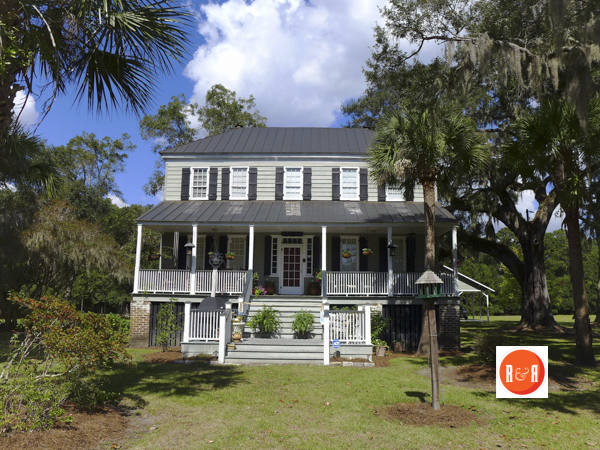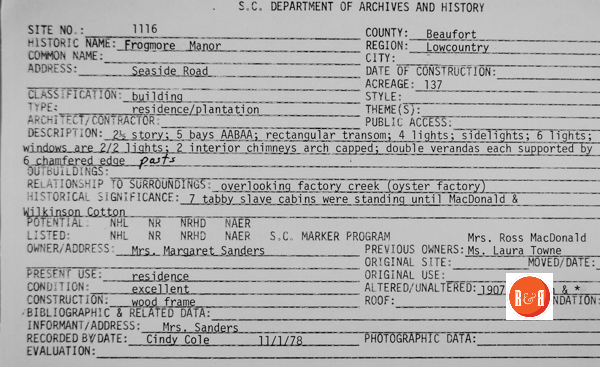City Directories and History: The Frogmore Plantation Complex is significant as an example of architectural development on St. Helena Island from ca. 1790 to ca.1920 and for its association with Laura Towne and Ellen Murray, the founders of Penn School, and with prominent St. Helena businessman James Ross Macdonald. The plantation was originally owned by Lt. Governor William Bull, who willed it to his son in 1750. The property passed into the hands of John and Elizabeth Stapleton in 1790; the house and barn were built ca. 1810,

Photo contributed to R&R by Gazie Nagle @ www.fineartbygazie.com
probably during their ownership. Thomas Coffin, owner of Coffin’s Point, owned Frogmore at his death in 1865. Three years later the house was purchased by Laura Towne and Ellen Murray.
Miss Towne and Miss Murray were two of the first Northern missionaries and teachers who arrived on St. Helena in March 1862 and founded Penn School. They enlarged the house and remained there until their deaths, in 1900 and 1908 respectively. The house and plantation were subsequently purchased by James Ross Macdonald. The complex consists of the main house, another residence built ca. 1940 (non-contributing), a cottage (non-contributing), a pump house, a carport/shed (non-contributing), a barn, and a windmill/water tower. The house was built as a one and one-half story structure in the early nineteenth century and enlarged to two and one-half stories in the late nineteenth century. In the early twentieth century the porch was enlarged from one to two stories. The rectangular barn is a significant example of tabby construction. Listed in the National Register May 26, 1989. [Courtesy of the SC Dept. of Archives and History]
“The builder of the Frogmore Plantation House and the tabby barn known. Both structures were built in the late eighteenth century, as was of tabby slave cabins razed in the 1930’s. The frame house was originally one-and-a-half stories on a raised foundation. Five bays in the “AABAA” pattern span the facade of the roofed structure. The main entrance is flanked by sidelights and a rectangular transom. Windows are nine over nine (9/9) lights with blinds. The house two interior chimneys.
The 1863 tax sale lists Frogmore Plantation as being “Coffin’s Frogmore,” indicating that the plantation was owned by Thomas Aston Coffin. Coffin was one of the most successful of the sea island cotton planters lived at Coffin Point Plantation. In 1868 Miss Laura Towne, teacher at Penn School and part of the Royal Experiment, purchased Frogmore. The published diary of Laura states in an entry dated January 10, 1869: “The second story looks very so far, but I shall not enjoy it till I see the roof on.” It was obviously Towne who enlarged the house from one-and-a-half stories to two-and-The upper verandah was added by James Ross MacDonald after Towne’s death.”
Information from: Historic Resources of the Lowcountry, The Lowcountry Council of Government, Cynthia C. Jenkins, Preservation Planner – Published, 1979
Stay Connected
Explore history, houses, and stories across S.C. Your membership provides you with updates on regional topics, information on historic research, preservation, and monthly feature articles. But remember R&R wants to hear from you and assist in preserving your own family genealogy and memorabilia.
Visit the Southern Queries – Forum to receive assistance in answering questions, discuss genealogy, and enjoy exploring preservation topics with other members. Also listed are several history and genealogical researchers for hire.
User comments welcome — post at the bottom of this page.
Please enjoy this structure and all those listed in Roots and Recall. But remember each is private property. So view them from a distance or from a public area such as the sidewalk or public road.
Do you have information to share and preserve? Family, school, church, or other older photos and stories are welcome. Send them digitally through the “Share Your Story” link, so they too might be posted on Roots and Recall.
Thanks!
User comments always welcome - please post at the bottom of this page.







Share Your Comments & Feedback: